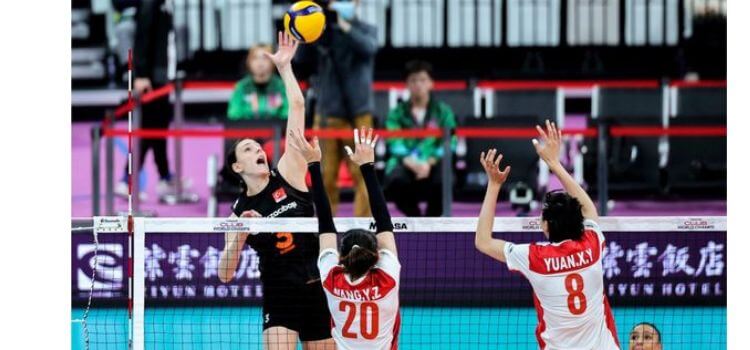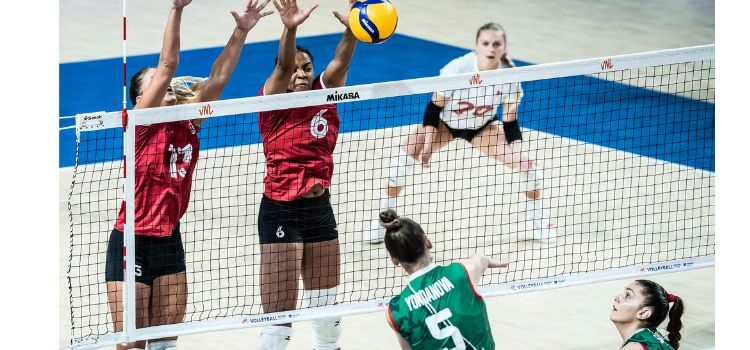As an Amazon Associate, I earn from qualifying purchases
Preparing for volleyball tryouts can be both exciting and nerve-wracking, especially if you’re aiming to make your high school or club volleyball team. Whether you’re a seasoned volleyball player or someone looking to showcase your developing volleyball skills, being well-prepared is key to standing out and making a great impression.
Here’s a comprehensive guide on what to bring to volleyball tryouts to ensure you’re ready to perform at your best.
Proper Attire: Dress for Success
When it comes to volleyball tryouts, dressing appropriately is key to making a strong impression and performing at your best. The right attire not only boosts your confidence but also ensures that you’re comfortable and able to move freely throughout the tryout.
Volleyball Shorts
One of the most important pieces of clothing you’ll need is a good pair of volleyball shorts. These should be snug enough to stay in place during quick movements but flexible enough to allow for a full range of motion.
Read More Used Volleyball Training equipment
Look for shorts made of lightweight, moisture-wicking fabric to keep you cool and dry, especially during intense drills and scrimmages.
Moisture-Wicking T-Shirt
Your choice of top is equally important. A moisture-wicking t-shirt is a smart choice because it helps to draw sweat away from your body, keeping you dry and comfortable.
Avoid wearing oversized or baggy shirts as they can restrict your movement and make it harder for coaches to assess your form and technique.
Comfort and Functionality
When selecting your attire, focus on comfort and functionality. Your clothing should allow you to move freely, jump, and dive without any restrictions.
Additionally, ensure that your outfit fits well and is appropriate for the tryout setting—neat and athletic, without being too flashy.
By dressing appropriately, you’ll not only feel more confident but also be better equipped to focus on showcasing your volleyball skills, rather than worrying about uncomfortable or restrictive clothing.
Footwear: Step Up Your Game
Your choice of footwear can significantly impact your performance during volleyball tryouts.
Volleyball Shoes: These shoes are specifically designed to provide the right mix of support, cushioning, and grip that you need on the court. Proper footwear can enhance your agility and reduce the risk of injury.
High-Quality Socks: Pair your shoes with high-quality, breathable socks that offer extra cushioning and support. It’s also a good idea to bring an extra pair in case your feet get sweaty during the tryout.
Essential Gear: Don’t Forget These Items
Bringing the right gear to volleyball tryouts is crucial for your comfort, safety, and overall performance. Being well-prepared with the essentials ensures that you can focus entirely on showcasing your volleyball skills without any distractions.

Here’s a checklist of must-have items you should bring with you.
Knee pads are a non-negotiable item for any volleyball player, especially during tryouts. They protect your knees during dives, slides, and falls, allowing you to play aggressively without fear of injury.
Make sure your knee pads fit snugly and provide ample cushioning so that you can move comfortably and confidently.
Ankle Braces
If you’re prone to ankle injuries or want to prevent them, bringing ankle braces is a good idea. They offer extra support and stability, reducing the risk of sprains or twists during quick lateral movements.
Read More Five Best Volleyball mikasa
This is especially important for players who rely heavily on their agility, like setters and defensive specialists.
Water Bottle
Staying hydrated is key to maintaining your energy levels throughout the tryout. Bring a large, refillable water bottle and make it a habit to take regular sips during breaks.
Dehydration can significantly impact your performance, so keep your water bottle within easy reach.
Towel
A small towel can be a lifesaver during intense tryouts. Use it to wipe off sweat and keep your hands dry between drills. This simple item can help you stay comfortable and focused on the game.
Healthy Snacks
Having some healthy snacks on hand can keep your energy up during breaks. Opt for quick, nutritious options like granola bars, nuts, or fruit. These snacks are easy to eat on the go and provide the fuel you need to stay sharp and energized.
By packing these essential items, you’ll be ready to tackle any challenge that comes your way during volleyball tryouts.
Being well-prepared not only boosts your confidence but also ensures that you can give your best performance on the court.
Volleyball Equipment: Be Ready for Anything
Sometimes, coaches might ask you to bring additional volleyball equipment to tryouts.
Your Own Volleyball: While not always required, bringing your own volleyball can show that you’re serious about your preparation. Make sure it’s properly inflated and ready for play.
Extra Knee Pads or Socks: It’s always smart to have backups, especially if you’re trying out multiple days or expect intense practice sessions.
Personal Identification and Paperwork
Don’t overlook the importance of bringing the necessary documents and identification to your tryout.
School ID or Driver’s License: You’ll likely need some form of identification when you arrive at the tryouts, especially if you’re trying out for a school team.
Tryout Forms: Ensure you have all the required forms, such as parental consent if you’re under 18, and medical clearance forms to prove you’re fit to participate.
Mental Preparation: The Right Mindset
Your mental state is just as important as your physical readiness. Here’s how to get your head in the game.
Positive Attitude: Go into the tryout with a positive attitude. Confidence can make a significant difference in how you perform and how coaches perceive you.
Focus on Your Volleyball Skills: Stay focused on showcasing your volleyball skills. This is your chance to demonstrate your skill level and prove that you’re a valuable asset to the team.
Physical Preparation: Warming Up is Crucial
Being physically prepared for volleyball tryouts is essential to performing your best and avoiding injury.
Warm-Up Routine: Start with a dynamic warm-up routine, including light jogging, stretching, and mobility exercises to get your muscles ready for action.
Conditioning Drills: Coaches often look for players with good conditioning. Incorporate agility drills, sprints, and endurance exercises into your warm-up to ensure you’re ready for the demands of the tryout.
Understanding the Game: Know Your Role
Having a solid understanding of the game and your role within it can give you a competitive edge during tryouts.
Familiarity with Positions: Be familiar with the different positions on the court and understand where your volleyball skills fit best. Whether you’re trying out as a setter, hitter, or defensive specialist, knowing your strengths will help you stand out.
Basic Volleyball Plays: Coaches appreciate players who are knowledgeable about basic volleyball plays and can execute them during drills or scrimmages.
Team Spirit: Show That You’re a Team Player
Volleyball is a team sport, and your ability to work well with others is just as important as your individual skills.
Communication Skills: Strong communication is vital on the volleyball court. Show that you can effectively communicate with your teammates and coaches during the tryout.
Supportive Attitude: Encourage and support your fellow players. A positive and supportive attitude can make a lasting impression on the coaches.
What Coaches Are Looking For: Understand Their Expectations
Knowing what coaches are looking for can help you tailor your performance during tryouts.
Skill Level and Potential: Coaches assess not only your current skill level but also your potential for improvement. Show that you’re eager to learn and grow as a volleyball player.
Coachability: Being coachable is a highly valued trait. Demonstrate that you’re open to feedback and willing to make adjustments based on the coaches’ instructions.
Recovery: Take Care of Your Body
Physical Recovery
Physical recovery involves the restoration of your muscles, joints, and bones after they’ve been stressed. This includes everything from a simple stretch after a workout to taking a full day off from exercise.
Mental and Emotional Recovery
Your mind needs recovery just as much as your body. Mental and emotional stress can take a toll on your physical health, so it’s essential to incorporate activities that relax and rejuvenate your mind.
Importance of Sleep in Recovery
How Sleep Affects Physical Recovery
Sleep is like a full-service repair shop for your body. During sleep, your body goes through various stages, each playing a unique role in recovery. REM sleep, for instance, is essential for cognitive recovery, while deep sleep is crucial for physical repair.
Tips for Improving Sleep Quality
Improving your sleep isn’t just about getting more hours; it’s about getting better sleep. Create a bedtime routine, keep your bedroom cool, and avoid screens before bed to ensure you’re getting the restorative sleep your body craves.
Nutrition for Optimal Recovery
Essential Nutrients for Recovery
Just as your car needs fuel to run, your body needs nutrients to recover. Protein is vital for muscle repair, while carbohydrates replenish energy stores. Don’t forget about vitamins and minerals like vitamin C and magnesium, which support the recovery process.
Hydration: Why It Matters
Staying hydrated is crucial for every bodily function, and recovery is no exception. Water helps transport nutrients to your muscles, flush out toxins, and keep your joints lubricated. Aim to drink water consistently throughout the day, not just during workouts.
Active Recovery Techniques
Stretching and Mobility Exercises
Stretching helps to increase blood flow to your muscles, reducing stiffness and speeding up recovery. Incorporating mobility exercises can also improve your range of motion, preventing injuries and enhancing performance.
Low-Intensity Workouts and Their Benefits
Active recovery doesn’t mean you have to sit still. Low-intensity activities like walking, cycling, or yoga keep your body moving without the stress of a full-blown workout, aiding in recovery while still burning calories.
Passive Recovery Techniques
The Power of Rest Days
Sometimes, the best thing you can do is nothing at all. Rest days give your body the time it needs to repair and rebuild. It’s a crucial part of any fitness regimen and should never be skipped.
Benefits of Massage and Foam Rolling
Massage and foam rolling are excellent ways to relieve muscle tension and improve circulation. These techniques help to break up scar tissue, reduce inflammation, and enhance the recovery process.
Mental and Emotional Recovery Strategies
Importance of Mental Health in Overall Recovery
Mental health and physical health are two sides of the same coin. Stress, anxiety, and depression can all hinder your body’s ability to recover, making mental recovery just as important as physical recovery.
Techniques for Stress Management
Incorporate stress management techniques like deep breathing, meditation, or even spending time in nature to support your mental recovery. These practices help calm the mind, reduce stress hormones, and promote overall well-being.
Using Technology to Enhance Recovery
Wearable Devices and Recovery Tracking
Technology can be a great ally in your recovery journey. Wearable devices like fitness trackers can monitor your sleep, heart rate, and activity levels, providing valuable insights into your recovery status.
Apps and Tools for Better Sleep and Relaxation
There are numerous apps designed to improve your sleep and relaxation. From guided meditations to white noise generators, these tools can help you create the perfect environment for recovery.
Injury Recovery and Prevention
How to Recover from Injuries Safely
Injuries are a part of life, especially if you’re active. The key to a speedy recovery is to follow a proper rehabilitation plan, which might include rest, physical therapy, and gradually returning to activity.
Prevention Strategies to Avoid Future Injuries
Prevention is better than cure. Incorporate strength training, proper warm-ups, and flexibility exercises into your routine to prevent injuries before they happen.
Signs of Overtraining and Inadequate Recovery
Common Symptoms of Overtraining
Overtraining occurs when your body doesn’t get enough time to recover between workouts. Symptoms include chronic fatigue, irritability, and decreased performance. If you notice these signs, it’s time to dial back and focus on recovery.
How to Adjust Your Routine for Better Recovery
If you’re overtraining, consider adjusting your workout routine. This might mean reducing workout intensity, increasing rest days, or incorporating more recovery activities like yoga or stretching.
The Role of Professional Help in Recovery
When to Seek Help from a Physiotherapist
Sometimes, DIY recovery just isn’t enough. If you’re dealing with persistent pain or a significant injury, it’s essential to seek help from a physiotherapist who can provide targeted treatment and advice.
The Benefits of Working with a Recovery Coach
A recovery coach can help you develop a personalized recovery plan, ensuring you’re doing everything you can to stay healthy and strong. They can provide guidance on nutrition, sleep, and exercise tailored to your specific needs.
Mind-Body Connection in Recovery
How Mental Health Affects Physical Recovery
The mind and body are deeply interconnected. If your mental health is suffering, your physical recovery will too. Practices like mindfulness, yoga, and meditation can help maintain this balance, supporting overall recovery.
Conclusion: Be Prepared, Stay Positive
Volleyball tryouts are your chance to showcase your skills, but being prepared is half the battle. Make sure you bring all the necessary gear, stay mentally and physically prepared, and keep a positive attitude throughout the process.
Remember, whether you make the team or not, each tryout is an opportunity to learn and grow as a volleyball player.
Frequently Asked Questions
1. What if I forget something?
Don’t panic. Focus on the essentials, and if you forget something minor, do your best without it. Being adaptable is also a valuable skill.
2. How early should I arrive at tryouts?
It’s a good idea to arrive at least 15-20 minutes early. This gives you time to check in, warm up, and get mentally prepared.
3. What should I do if I’m nervous?
Nerves are normal. Take deep breaths, focus on your volleyball skills, and remember that everyone is there for the same reason—to do their best.
4. How many tryouts should I attend?
If multiple tryouts are offered, attend as many as possible. This increases your chances of being noticed and shows your dedication.
5. What if I don’t make the team?
If you don’t make the team, don’t be discouraged. Use the experience as a learning opportunity, and continue to work on improving your skills for next time.

